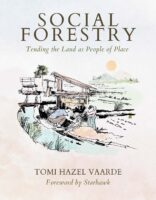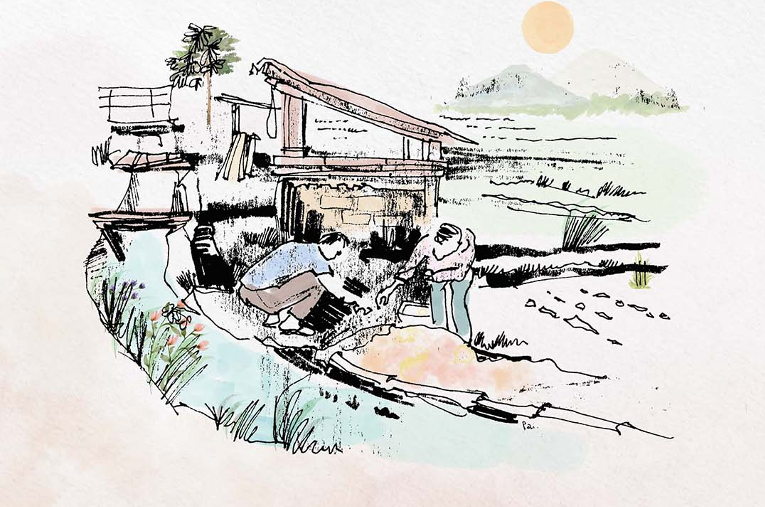 Ed. note: This piece is excerpted with permission from the Introduction in the new book Social Forestry: Tending the Land as People of Place, by Tomi Hazel Vaarde, and published by Synergetic Press. You can find out more about the book here.
Ed. note: This piece is excerpted with permission from the Introduction in the new book Social Forestry: Tending the Land as People of Place, by Tomi Hazel Vaarde, and published by Synergetic Press. You can find out more about the book here.
This call is to do culture-tending. We will only learn the good ways by getting out there together and experiencing the wild. Then, as we re-wild ourselves and our relationships, we will find some relief from eco-grief, as empires crumble and ecosystems recover.
The whole planet needs some Humans to do headwater-forest repair work. The path to the real work on the land is a deep, well-worn evolutionary way of becoming more mature and wise Humans. This is a way of hope and beauty.
The mountain forests, meadows, and streams on the Pacific slope of North America would benefit from tending and ecosystem functions repair. Logging, grazing, road building, and mining have degraded these headwaters and ridgelines so severely that rain does not fall, runoff does not sink in, and the carrying capacity for native plants, animals, and peoples has failed to show resilience and fecundity. Forests are declining and catastrophes are increasing. What can we do?
Humans can be useful, their disturbance regimes1 can facilitate ecosystem function enhancement. On the west slopes of Turtle Island, our compelling vision is the return of Salmon, Beaver, and Fire. This net of totemic icons implies ecosystem functions2 that support immense complexity and enhance biodiversity. This is the Ecotopian3 imperative: become People of Place and find a way to heal our relationships, for the benefit of All.
With familiarity and Place-knowledge, we come together in council and accept the ultimate welcome: the restoration of kinship and webs of relations. The deep feelings of belonging, included in council, our membership in complexity.
The forests, woodlands, prairies, brush fields, stream sides, and ridgelines miss us. If you feel the call, start with The Healing Magic of Forest Bathing (Plevin 2019); meet the trees wide open, senses tingling. Move deeper in with hikes and treks, camps and trails. Social Forestry as an intention-of-culture contains a whole set of options that we deploy as needed and appropriate. The important key here is social—we do this together.
The great majority of detailed momentary decisions are made by guild-groups, drifting or swarming through edges and patches of ecological mosaics. The learned principles that could guide these decisions are so vast and numerous that too much thinking interferes with intuition and skilled practice. We also need to learn pattern-language, systems logic. The principles we have collected and experienced highlight the lessons of Traditional Ecological Knowledge, land-based knowledge kept in culture through stories.
Observation and noticing are fine-tuned so that mutual aid and translations flow, tickling out emergent complexities noticed on the margins of awareness. We pay attention to these essential clues, many of them learned from stories. “Then Coyote turned and looked back, a flash of green from under a log . . . ” reminds us of fragile glow worms that puzzled us until we heard and then saw, to our delight. Markers of moisture and complex soil life.
We suggest that you find friends that live nearby, you-all might start culture repair with the practice of Salon, a traditional way to share and discuss, without argument or dialog, where participants speak to everyone gathered, and the flow is connective not contrary. As depth of community enriches through imagination and creativity allowed in Salon, you-all might move on to community inventory, re-skilling gatherings, group woods-work with local mentors, and eventually into passion-groupings we call guilds. As guilds learn to sit in spokescouncils4, and neighborhoods learn to sit in drainage basin councils, wise-culture emerges—informed by accumulating knowledge of Place.
WHAT THIS BOOK INTENDS
Whatever the shape of our specific Place, there are Social Forestry ways to address concerns and necessities. We all need to learn a lot, and make commitments with others. But ultimately we will not learn from books, even this one—the real work and the details of process are Place-specific. Here we have assembled ideas and inspirations, stories and lists, to tickle the imagination, and act as checklists for council deliberations. Ultimately, we who take up the passion to change the paradigm will need the space, support, and opportunity to do the practice. We will need the guidance of local people, local biodiversity, and local conditions.
This book is not merely a recipe collection, where the reader can pick and choose their indulgences; rather, we want to suggest that all skills and opportunities are embedded in cultural contexts that shape action and involvement in complex ways that a book cannot fully enfold. This book offers a sprinkle of stories and ideas, but we also need a flood of dedication and investment.
We hope our stories, examples, lists, and principles lend the reader and their community guidance and a lens for how to think about what can be done. The actual doing is far more contingent on real time and Place—we can only offer grist from what we have seen, heard, expected, and done. We leaven with suggestions and opinions, however, so excuse the sometimes directive (effervescent) tone, where we lay out sequences and linear dispositions. We beg your forgiveness; do not be misled, let your Place do the guiding. As Arne Naess, the Norwegian deep ecologist says, “Pay attention, but don’t buy it!”
1 Moving or adjusting elements of an ecosystem while tending or harvesting, disturbing as a type of tending.
2 The net benefits of complex landscape scale flows that deliver clean water, healthy air, biodiversity, and resilience to disruptions.
3 Ecologically oriented culture in Northern California and the Pacific Northwest.
4 A council of delegates from other councils.





